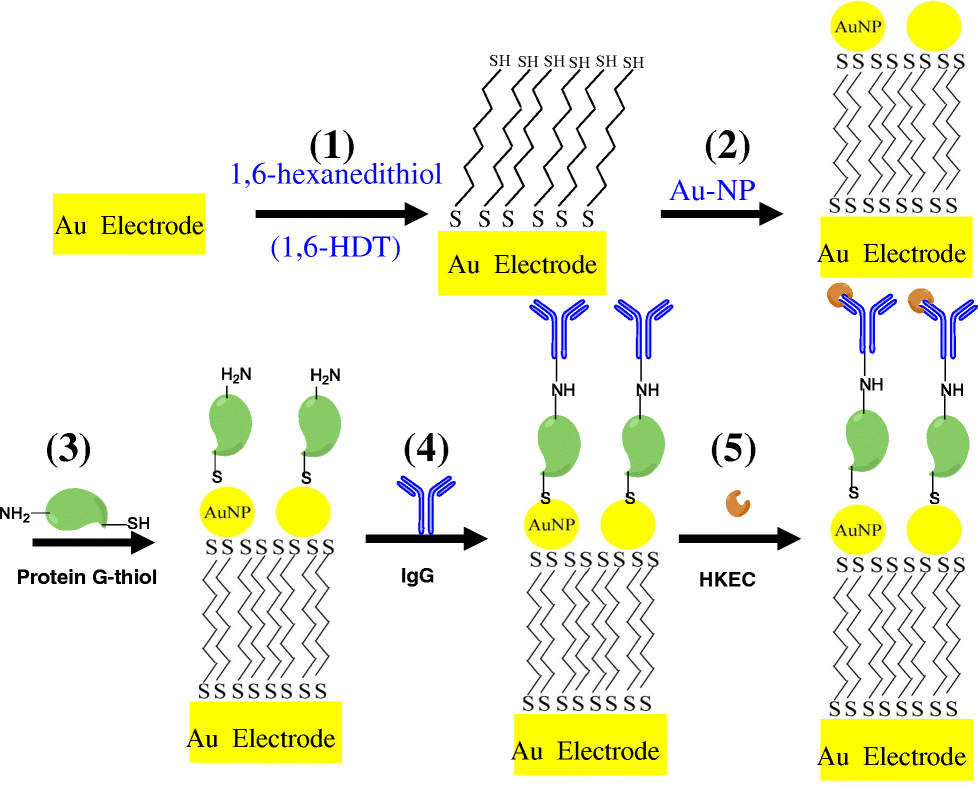当前位置:
X-MOL 学术
›
Microchim. Acta
›
论文详情
Our official English website, www.x-mol.net, welcomes your
feedback! (Note: you will need to create a separate account there.)
An impedimetric biosensor for E. coli O157:H7 based on the use of self-assembled gold nanoparticles and protein G
Microchimica Acta ( IF 5.3 ) Pub Date : 2019-02-11 , DOI: 10.1007/s00604-019-3282-3 Donghai Lin , Rajesh G. Pillai , William Edward Lee , Abebaw B. Jemere
Microchimica Acta ( IF 5.3 ) Pub Date : 2019-02-11 , DOI: 10.1007/s00604-019-3282-3 Donghai Lin , Rajesh G. Pillai , William Edward Lee , Abebaw B. Jemere

|
AbstractTwo kinds of electrochemical impedimetric biosensors for the detection of E. coli O157:H7 are described and compared. They were fabricated using self-assembled layers of thiolated protein G (PrG-thiol) on (i) planar gold electrodes and (ii) gold nanoparticles (Au NPs) modified gold electrodes. The fabrications of the biosensors were characterized using cyclic voltammetry, electrochemical impedance spectroscopy, scanning electron microscopy and atomic force microscopy techniques. The modification of the planar gold electrode by Au NPs via self-assembled monolayer of 1,6-hexadithiol as a linker molecule increased the electrochemically active surface area by about 2.2 times. The concentration of PrG-thiol and its incubation time, as well as the concentration of IgG were optimized. The Au NP-based biosensor exhibited a limit of detection of 48 colony forming unit (cfu mL−1) which is 3 times lower than that of the planar gold electrode biosensor (140 cfu mL−1). It also showed a wider dynamic range (up to 107 cfu mL−1) and sensitivity. The improved analytical performance of the Au NP-modified biosensor is ascribed to the synergistic effect between the Au NPs and the PrG-thiol scaffold. The biosensor exhibited high selectivity for E. coli O157:H7 over other bacteria such as Staphylococcus aureus and Salmonella typhimurium. Graphical abstractSchematic representations of sensor fabrication using Au NP-modified electrode (HKEC = heat- killed E. coli O157:H7).
中文翻译:

基于自组装金纳米粒子和蛋白 G 的大肠杆菌 O157:H7 阻抗生物传感器
摘要 描述并比较了两种用于检测大肠杆菌O157:H7 的电化学阻抗式生物传感器。它们是在 (i) 平面金电极和 (ii) 金纳米粒子 (Au NPs) 修饰的金电极上使用自组装层硫醇化蛋白 G (PrG-硫醇) 制造的。使用循环伏安法、电化学阻抗谱、扫描电子显微镜和原子力显微镜技术对生物传感器的制造进行了表征。通过 1,6-己二硫醇的自组装单层作为连接分子,Au NPs 对平面金电极的修饰使电化学活性表面积增加了约 2.2 倍。优化了 PrG-硫醇的浓度及其孵育时间,以及 IgG 的浓度。基于Au NP的生物传感器的检测限为48个菌落形成单位(cfu mL-1),比平面金电极生物传感器(140 cfu mL-1)低3倍。它还显示出更宽的动态范围(高达 107 cfu mL-1)和灵敏度。Au NP 修饰的生物传感器分析性能的提高归因于 Au NPs 和 PrG-硫醇支架之间的协同作用。该生物传感器对大肠杆菌 O157:H7 的选择性高于其他细菌,如金黄色葡萄球菌和鼠伤寒沙门氏菌。图形摘要使用 Au NP 修饰电极(HKEC = 热灭活大肠杆菌 O157:H7)制造传感器的示意图。它还显示出更宽的动态范围(高达 107 cfu mL-1)和灵敏度。Au NP 修饰的生物传感器分析性能的提高归因于 Au NPs 和 PrG-硫醇支架之间的协同作用。该生物传感器对大肠杆菌 O157:H7 的选择性高于其他细菌,如金黄色葡萄球菌和鼠伤寒沙门氏菌。图形摘要使用 Au NP 修饰电极(HKEC = 热灭活大肠杆菌 O157:H7)制造传感器的示意图。它还显示出更宽的动态范围(高达 107 cfu mL-1)和灵敏度。Au NP 修饰的生物传感器分析性能的提高归因于 Au NPs 和 PrG-硫醇支架之间的协同作用。该生物传感器对大肠杆菌 O157:H7 的选择性高于其他细菌,如金黄色葡萄球菌和鼠伤寒沙门氏菌。图形摘要使用 Au NP 修饰电极(HKEC = 热灭活大肠杆菌 O157:H7)制造传感器的示意图。
更新日期:2019-02-11
中文翻译:

基于自组装金纳米粒子和蛋白 G 的大肠杆菌 O157:H7 阻抗生物传感器
摘要 描述并比较了两种用于检测大肠杆菌O157:H7 的电化学阻抗式生物传感器。它们是在 (i) 平面金电极和 (ii) 金纳米粒子 (Au NPs) 修饰的金电极上使用自组装层硫醇化蛋白 G (PrG-硫醇) 制造的。使用循环伏安法、电化学阻抗谱、扫描电子显微镜和原子力显微镜技术对生物传感器的制造进行了表征。通过 1,6-己二硫醇的自组装单层作为连接分子,Au NPs 对平面金电极的修饰使电化学活性表面积增加了约 2.2 倍。优化了 PrG-硫醇的浓度及其孵育时间,以及 IgG 的浓度。基于Au NP的生物传感器的检测限为48个菌落形成单位(cfu mL-1),比平面金电极生物传感器(140 cfu mL-1)低3倍。它还显示出更宽的动态范围(高达 107 cfu mL-1)和灵敏度。Au NP 修饰的生物传感器分析性能的提高归因于 Au NPs 和 PrG-硫醇支架之间的协同作用。该生物传感器对大肠杆菌 O157:H7 的选择性高于其他细菌,如金黄色葡萄球菌和鼠伤寒沙门氏菌。图形摘要使用 Au NP 修饰电极(HKEC = 热灭活大肠杆菌 O157:H7)制造传感器的示意图。它还显示出更宽的动态范围(高达 107 cfu mL-1)和灵敏度。Au NP 修饰的生物传感器分析性能的提高归因于 Au NPs 和 PrG-硫醇支架之间的协同作用。该生物传感器对大肠杆菌 O157:H7 的选择性高于其他细菌,如金黄色葡萄球菌和鼠伤寒沙门氏菌。图形摘要使用 Au NP 修饰电极(HKEC = 热灭活大肠杆菌 O157:H7)制造传感器的示意图。它还显示出更宽的动态范围(高达 107 cfu mL-1)和灵敏度。Au NP 修饰的生物传感器分析性能的提高归因于 Au NPs 和 PrG-硫醇支架之间的协同作用。该生物传感器对大肠杆菌 O157:H7 的选择性高于其他细菌,如金黄色葡萄球菌和鼠伤寒沙门氏菌。图形摘要使用 Au NP 修饰电极(HKEC = 热灭活大肠杆菌 O157:H7)制造传感器的示意图。











































 京公网安备 11010802027423号
京公网安备 11010802027423号